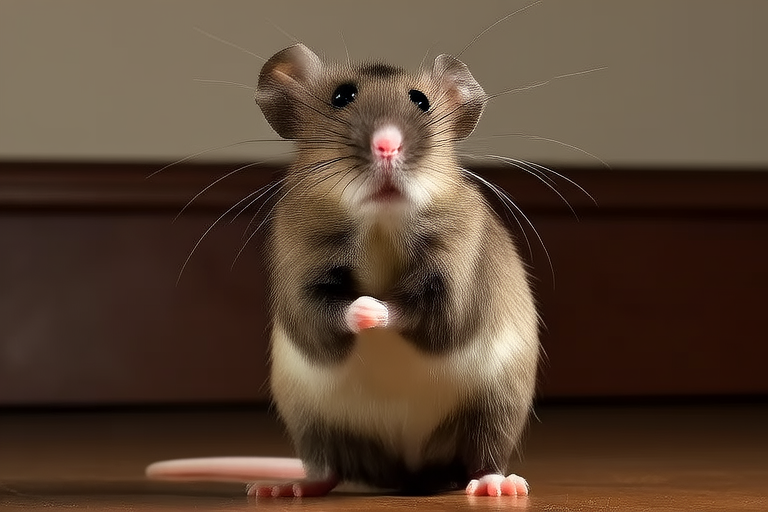Understanding Your Fancy Rat’s Body Language: Decode Their Secret Signals
Welcome to the fascinating world of fancy rats! These intelligent and social creatures can communicate a wealth of information through their body language. Understanding your rat’s body language is crucial for providing better care and strengthening the bond between you and your pet. By learning to read their secret signals, you can ensure they’re happy, healthy, and comfortable. Let’s dive into the intricate world of rat communication and explore the nuances of their body language.
The Importance of Understanding Your Rat’s Body Language
Rats are highly social animals that thrive on interaction and affection. Understanding their body language allows you to respond to their needs promptly, ensuring their well-being. It also enhances your connection with your pet, making playtime more enjoyable and fostering a deeper relationship. By becoming fluent in their non-verbal cues, you’ll be able to provide them with the best possible care.
Common Signals: Tail Positions, Ear Movements, Whisker Gestures, and Body Postures
Tail Positions
Your rat’s tail can reveal a lot about their mood. A relaxed rat will have its tail hanging loosely or curled gently around its body. If the tail is held high and stiff, it may indicate excitement or arousal. Conversely, a tucked tail could signal fear or submission. Pay attention to how your rat holds its tail; it can be a clear indicator of their emotional state.
Ear Movements
Ears are another vital component of rat communication. Erect ears suggest alertness and interest, while flattened ears might indicate fear, discomfort, or aggression. Rats may also rotate their ears to listen more effectively, so watch out for this subtle movement. Understanding ear movements can help you gauge your rat’s level of engagement or anxiety.
Whisker Gestures
Whiskers are sensitive appendages that rats use to navigate their environment and express emotions. Forward-facing whiskers usually mean the rat is calm and content, while twitching or flicking whiskers could signal agitation or curiosity. Observing your rat’s whisker movements can offer valuable insights into their current state of mind.
Body Postures
Body posture is perhaps the most expressive form of rat communication. A relaxed rat will have a loose, natural stance, whereas a tense or hunched posture might indicate stress or discomfort. Playful rats often display a more upright and energetic stance, while fearful rats may cower or flatten themselves against surfaces. Familiarizing yourself with various body postures can greatly enhance your ability to understand your rat’s emotional state.
Distinguishing Between Playful and Fearful Behaviors
It’s essential to differentiate between playful and fearful behaviors to ensure your rat feels safe and secure. Playful rats are often more active, displaying bouncy movements and exploring their surroundings with enthusiasm. They may also engage in social behaviors like grooming or playing with toys. In contrast, fearful rats tend to be more cautious and may retreat to dark corners or hide behind objects. Learning to distinguish these behaviors can help you provide a supportive and enriching environment for your pet.
Recognizing Signs of Health Issues Through Body Language
Body language can also serve as an early warning system for potential health problems. Lethargy, loss of appetite, and unusual behavior patterns can all be signs of illness. For instance, if your rat is typically active but suddenly becomes sluggish, it might be time to consult a veterinarian. Similarly, changes in eating habits or unusual vocalizations could indicate underlying health issues. Regular observation and prompt action can make a significant difference in your rat’s overall health.
How to Respond Appropriately to These Signals
Responding appropriately to your rat’s body language is key to maintaining a positive relationship. If your rat displays signs of fear or discomfort, provide reassurance by speaking softly and offering treats. Avoid forcing interactions when your rat is clearly anxious. Conversely, if your rat exhibits playful behavior, engage in interactive activities that encourage social bonding. Always respect your rat’s boundaries and respond with empathy and understanding.
Tips for Observing Your Rat Regularly
To become more adept at interpreting your rat’s unique communication style, regular observation is essential. Spend quality time with your pet each day, noting any changes in behavior or physical appearance. Keep a journal to track your observations and identify patterns over time. This practice will not only deepen your understanding of your rat’s individuality but also strengthen your bond. Remember, every rat is different, so take the time to learn what makes your pet tick.
In conclusion, understanding your fancy rat’s body language is a rewarding endeavor that enhances both their well-being and your relationship. By paying close attention to tail positions, ear movements, whisker gestures, and body postures, you can better interpret their secret signals and respond appropriately. Distinguishing between playful and fearful behaviors, recognizing signs of health issues, and responding with empathy will ensure your rat enjoys a happy and healthy life. With consistent observation and care, you’ll become a master at decoding your rat’s unique communication style.
